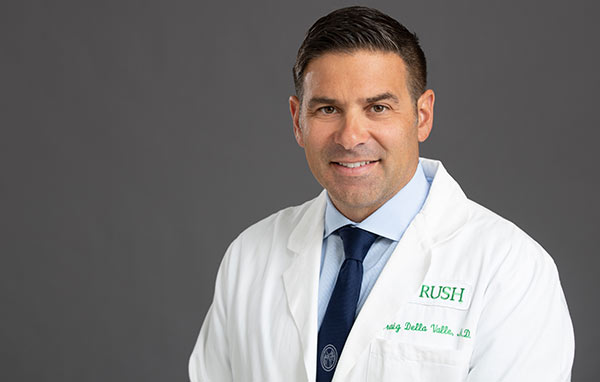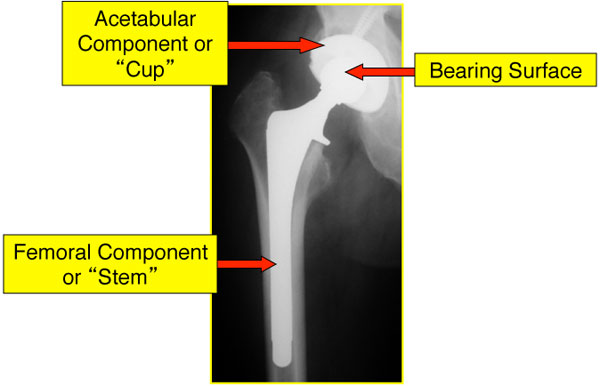
About Dr. Della Valle
Dr. Della Valle is a professor of Orthopaedic Surgery at Rush University Medical Center. He is not only a busy surgeon (having performed more than 11,000 hip and knee replacements) but a respected leader in the field of hip and knee research. He travels extensively sharing his research and these experiences allow him exposure to the most up to date information to maximize patient quality of care.
More about Dr. Della Valle Dr. Della Valle's CV Schedule an AppointmentAnatomy of a Total Hip Replacement

How long does it take to recover from a hip replacement?
Most patients can do most things by 6 weeks after surgery.
What surgical approach to the hip do you use for your hip replacements?
We typically perform a posterior approach to the hip. This is the most commonly used surgical approach to the hip in the USA. It is relatively simple and allows for excellent surgical exposure and is compatible with a rapid recovery and minimal postoperative pain.
Do you perform the anterior approach to the hip?
At this time, I do not routinely perform an anterior approach to the hip. There are several variations of anterior approaches to the hip with the most recent or “popular” being a direct anterior approach.
Several years ago I was doing an anterior approach to the hip. Initially we thought this was better than the posterior approach that we were doing so we did a study where we “randomized” patients to either the anterior or a posterior approach to the hip. Turns out, we were wrong! There were no differences in postoperative pain or recovery between the two approaches. The only differences were a little longer operative time with the anterior approach and a little more blood loss. Hence, we stopped doing the anterior approach.
How long do I have to use a walker, crutches or a cane?
We ask that patients use at least SOMETHING for the first six weeks after surgery. This can be a walker, crutches, one crutch or a cane. This makes a big difference in terms of the forces across your hip joint and will protect if while the implants are healing to the bone. If someone tells you that you don’t need to use your assist device earlier than six weeks please ask that health care provider to call our office.
Can I return to work after total hip replacement surgery?
Most patients are comfortable returning to work 6-8 weeks after surgery. We can provide a maximum recovery time of 12 weeks.
Journal Article: Do patients return to work after hip arthroplasty surgery »
What are the total hip replacement surgery components made of?
The components for the most part are made of titanium.
What bearing surface do you use and what is the difference?
The bearing surface we use most commonly is a plastic liner and a metal head. In some instances we may use a ceramic head or a head made of a ceramicized metal. There are some situations (generally younger female patients) where we will consider the use of a ceramic on ceramic bearing.
Most of the data suggests that the lowest risk of failure is associated with plastic liner and a metal head.
What if I have an allergy to metals?
The most common “allergy” to metals is skin sensitivity to nickel. While most of the scientific data suggests little relationship between skin sensitivity and a true allergy, if you have a skin sensitivity to nickel please let us know and we can avoid nickel containing implants (although the amount of nickel in standard components is very small).
What are my restrictions after total hip replacement surgery?
In general, we ask patients to avoid running and jumping after standard hip replacement surgery. If you are interested in returning to running sports, please see the section about Hip Resurfacing and ask us about it when you come to your office visit.
We also ask patients to avoid extreme range of hip motion. Similarly if you want to perform activities such as yoga that require more range of motion, please ask us at the time of your office visit and we can discuss specific options for you.
What about return to sex after total hip replacement surgery?
Research that included our patients showed that patients have sex more frequently and of better quality after hip replacement surgery.
In general, you should avoid extreme positions for the first 3 months after surgery and it is safest for you as the patient to be on the bottom during this time period.
Do I need formal physical therapy after surgery?
No, patients do not necessarily need formal physical therapy after hip replacement surgery. There is increasing data from research that suggests that if you took 100 patients who had their hip replaced, and half got physical therapy and half did exercises on their own at a year after surgery there does not seem to be much difference between the two groups of patients. If you want to go to physical therapy to learn how to use your assist device or for instruction on which exercises to do and how to do them we certainly encourage that. Midwest Orthopaedics at Rush now has six physical therapy locations (https://www.rushortho.com/clinical-staff/physical-therapists) and we highly recommend these facilities as we know the physical therapists there and they will call us directly if you are having any type of an issue or problem that we need to be aware of.
https://insights.ovid.com/pubmed?pmid=28419032
https://www.ncbi.nlm.nih.gov/pubmed/28506775









